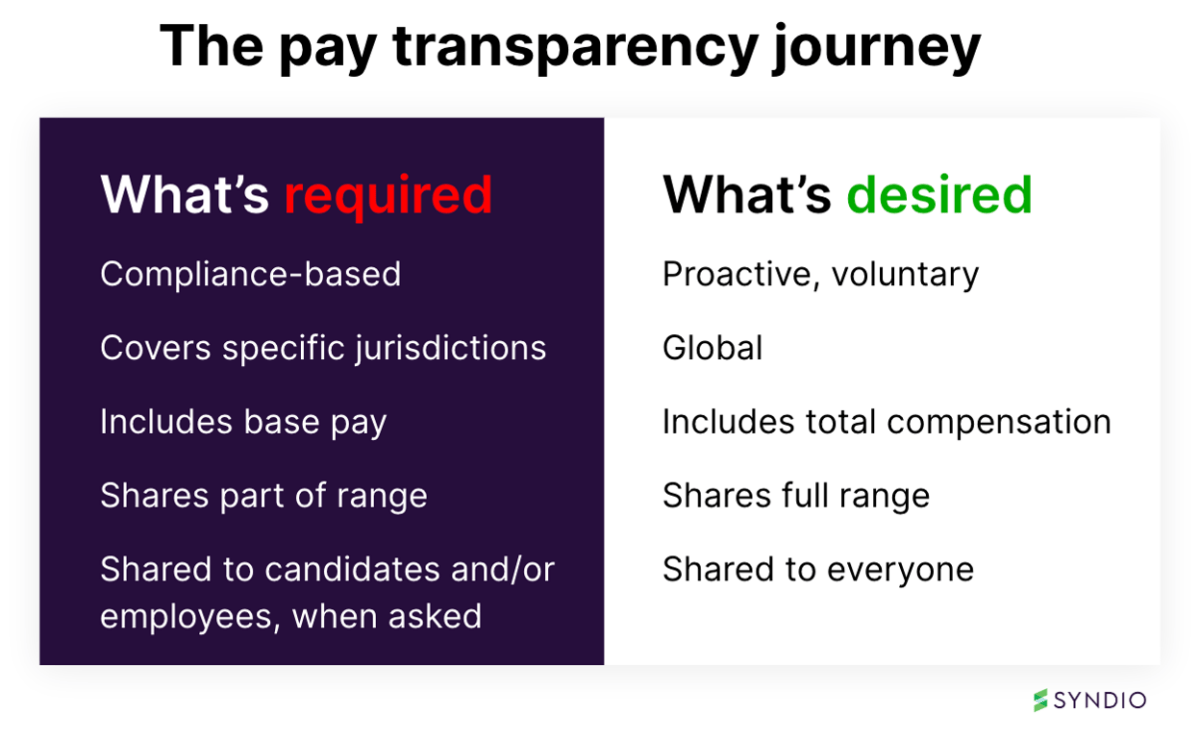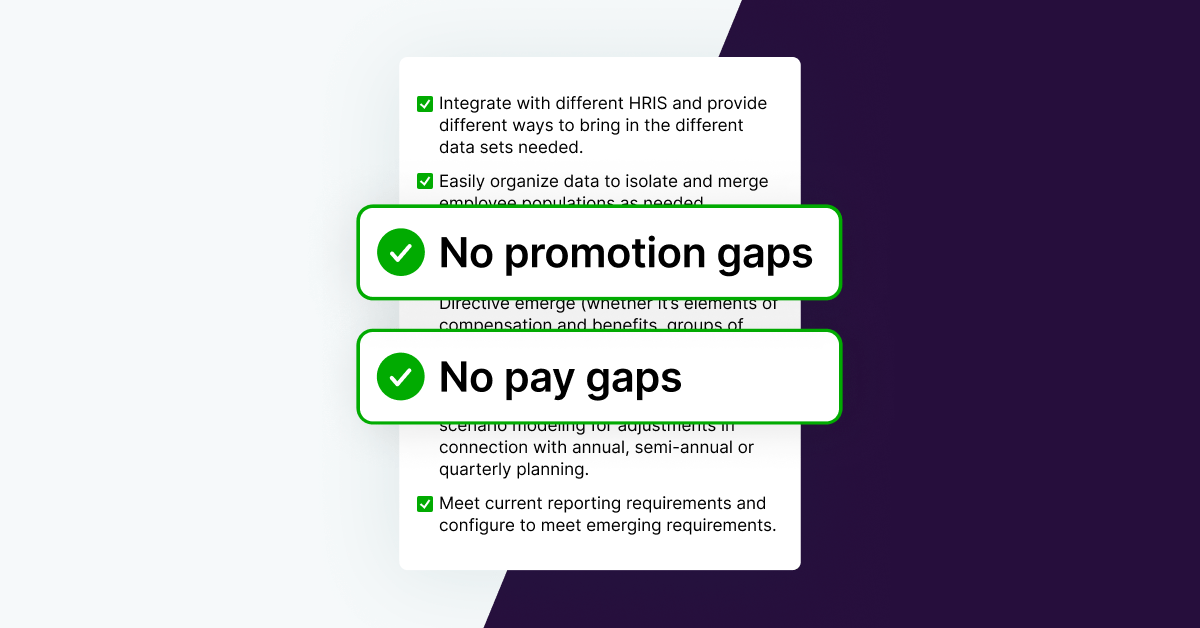“In a way, employees are compensation analysts now.”

To bridge this gap, we recently hosted a webinar on How to Train Your Managers to Discuss Pay Transparency, featuring Ann Oleson, Director of Global Compensation at Match Group, and Stacey Rapacki, VP of Compensation Strategy at Northwell Health, moderated by Syndio’s Senior Director of Total Rewards Strategy & Solutions, Nancy Romanyshyn. Here is their top guidance for training managers to engage in clear, open dialogue about pay.
1. Pay transparency is a change management challenge that you can approach in phases.
“We’re responding to legislation and regulations, but at the same time, [pay transparency] is more than just an exercise in compliance.”
– Stacey Rapacki, VP of Compensation Strategy at Northwell Health
Companies with mature pay transparency programs are moving from disclosing only “what’s required” for pay transparency compliance to proactively sharing “what’s desired” from employees, investors, consumers, job seekers, boards, and other stakeholders. But getting there won’t happen overnight. Implementing transparent pay practices can pose a change management challenge, as executives and board members may perceive the move toward greater transparency as a risk.
To bring leaders along in the change management journey, it’s essential to involve them from the beginning. Senior leaders need to understand the approach being taken, and they should be educated and trained like the rest of the leaders and managers. While it may feel scary to show ‘how the sausage is made’, it’s critical to be honest about where the company is today and where it’s going. Employees and candidates want to know what to expect for pay, and if the company doesn’t get ahead of the narrative, someone else will. People are posting ranges, screenshots, contracts, and other information related to salaries and wages, so it’s essential to shape and own your compensation story proactively.
The roadmap to achieving full pay transparency can be undertaken incrementally. By breaking down the process into phases, employers can create a plan that makes sense for their organization and gradually work towards full transparency. Ann shared the following phases of pay transparency:
- Pay equity transparency: Sharing the results of pay equity audits.
- Job posting transparency: Disclosing salary ranges in job listings.
- Global level transparency: Informing employees what their global level is and why they’re placed in a certain global level.
- Full individual pay range transparency: Sharing the minimum and maximum of the individual’s pay range and explaining why they are where they are in the range.
2. Start by building a solid foundation in your compensation architecture and philosophy.
“Our strategy was ‘Let’s build a foundation and make sure our comp philosophy and comp practices are on a solid foundation before we move on to pay transparency.”
– Ann Oleson, Director of Global Compensation at Match Group
To achieve pay transparency, it’s crucial to first build a solid foundation in a well-developed compensation architecture and philosophy. This enables employers to ensure they’re paying individuals competitively and equitably.
For example, Ann shared how Match Group took a global approach across 13 countries with global levels matching various requirements for each role. They then assigned pay ranges for each combination of global level and labor market/geography. This process provided them with a holistic but locally-relevant framework for employee pay. By doing the work of testing their pay ranges with their employee population and making adjustments where necessary, they ensured they were paying employees in each region fairly and competitively. When it came time to comply with relevant pay transparency laws, Match Group was well-prepared because they already had pay ranges that were more representative of how they were actually paying employees, and more useful to job seekers.
As Ann noted, Match Group’s strategy was to build a solid foundation and make sure their compensation philosophy and practices were on a strong footing before moving on to pay transparency. However, building this foundation takes time. For Match Group, it took a couple of years of forward-thinking and preparation for what was coming. But by taking the time to lay this groundwork and test their approach, Match Group is able to be confident in their pay ranges and more transparent in their communication about pay with employees.
3. Break pay transparency concepts into bite-sizes tailored to each stakeholder.
“At the heart of our [pay transparency] strategy, we have to communicate and meet requirements, but we also have to bring it to life for our leaders on the front line and in HR and talent acquisition. It’s not just about the numbers on the page. It’s about Total Rewards and the employee value proposition.”
– Stacey Rapacki, VP of Compensation Strategy at Northwell Health
The factors that go into pay are complex and nuanced, and can be fairly technical, so it’s important to break it down into digestible pieces and accessible language. At its core, pay transparency is much more than just a dry compliance exercise, so it is important to bring it to life for your front-line managers by tying it back to your company’s mission and culture. The big picture is not about the mechanics of pay, but rather how you think about your guiding compensation principles and how Total Rewards interacts with the employee value proposition.
To effectively break down pay transparency, it needs to be divided into bite-size pieces. It’s crucial to consider each stakeholder, ask “Who needs to know what?”, then provide resources, such as guides, toolkits, FAQs, and education sessions, to make it more accessible to them. For example, Northwell Health’s Total Rewards team took great care to demystify the New York pay range disclosure law to their team by explaining what it entails, how the company planned to comply, and what they were disclosing. Stacey noted that they also shared information that wasn’t required by law but which was important to Northwell Health to include.
4. Empower managers to respond to employee pay questions with clear pathways to resources.
“We took a ‘train the trainer’ approach to give [each of our portfolio brands] the autonomy to explain pay in ways that are most appropriate for their team. We worked with our HR folks to ensure they could deliver resources to managers: info sessions, a conversation script, career frameworks, etc.”
– Ann Oleson, Director of Global Compensation at Match Group
Effective pay transparency training for managers ensures that they have the necessary skills to manage and respond to employee questions about pay and benefits. One important aspect of this training is teaching leaders that if an employee asks a question in the moment, it’s okay to pause and say, “I don’t have the answer right now, let me get back to you.” Then give them paths to talk with HR and Talent Acquisition partners and subject matter experts to understand the principles governing that employee’s pay package, then come back and complete the conversation.” This approach helps build relationships and trust with employees while also ensuring that accurate information is provided.
For Northwell Health, pay differences may be related to acquired sites and hospitals with differences in geographic location, specialization, and contractually negotiated rates — but their foundational compensation philosophy and desire to be positioned in a certain place in the competitive market remains constant. To ensure leaders understand how they reached each pay decision and why, their Total Rewards team works closely with partners in HR and Talent Acquisition to explain pay differences and eligibility for different types of rewards. A core part of their messaging is that it’s about more than pay, it’s “pay PLUS”, which covers education differentials, uniform allowances, tuition reimbursement, retirement programs, and more. To help managers feel comfortable having these conversations, a core piece of training is answering “Where do I go to get the info I need for this conversation? Where do I go to understand what my team is eligible for? What are the differentiating factors by site and by level?”
Match Group took a ‘train the trainer’ approach to empower each of their portfolio brands to explain pay in the most appropriate manner for their teams. To accomplish this, they collaborated closely with each HR team to provide resources such as information sessions, conversation scripts, and career frameworks to managers, ensuring they were equipped to effectively communicate pay and benefits to their employees.
5. Treat pay communications with employees as an opportunity.
“Every [pay conversation] with a team member is an opportunity to talk to them about their development and career.”
– Stacey Rapacki, VP of Compensation Strategy at Northwell Health
Effective pay communications serve not only as a means to convey important information but also as an opportunity to reinforce key messages and establish one-on-one touchpoints with employees. As Ann noted, when employees come with questions about pay, it’s an opportunity for managers to highlight the Total Rewards package, which includes not just base salary but also benefits, bonuses, and equity. This helps employees understand their value to the company and reinforces how their compensation compares to the market as a complete rewards package, rather than just comparing their base salary to base salaries listed in job postings.
It’s also important to continuously review and ensure equitable pay internally and competitive pay externally. As Nancy noted, creating a feedback loop can help organizations stay informed about employee concerns and make adjustments as necessary.
Mastering pay transparency is critical for your employer brand
In order to own the narrative around your employer brand, it’s vital to become more transparent about pay. As Josh Bersin research shows, how employees perceive and feel about pay fairness is more important than the level of pay itself. In a LinkedIn Live with Walmart on the ROI of workplace equity, Ellen Exum, VP of Executive and Sam’s Club Total Rewards at Walmart, said that this feeling of fairness also comes from not only what information you share, but what you actually do around pay and opportunity.
Organizations should treat conversations about pay as an opportunity. By supporting managers to have the resources and knowledge they need to have open conversations with employees, organizations can build trust, strengthen relationships, and foster a culture of learning and growth.
The How to Train Your Managers to Discuss Pay Transparency webinar was packed with great advice, so watch the full webinar recording linked below for more insights.
The information provided herein does not, and is not intended to, constitute legal advice. All information, content, and materials are provided for general informational purposes only. The links to third-party or government websites are offered for the convenience of the reader; Syndio is not responsible for the contents on linked pages.



